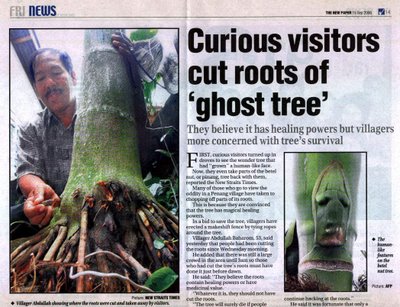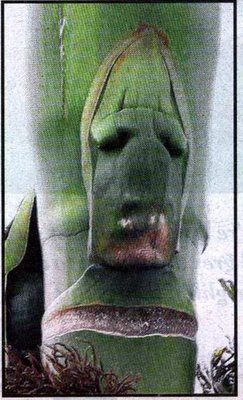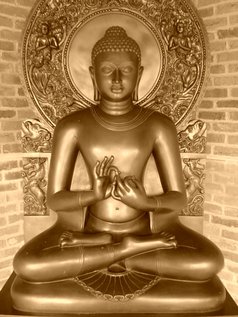 The odd looking Jow Ngaw เจ้าเงาะ is worshipped as a deity of prosperity by some Thais. Jow Ngaw originally refered to a character in a literature by King Rama II - SangThong สังข์ทอง, the original work is in poem form but there are simplified versions for children and an animation was also made.
The odd looking Jow Ngaw เจ้าเงาะ is worshipped as a deity of prosperity by some Thais. Jow Ngaw originally refered to a character in a literature by King Rama II - SangThong สังข์ทอง, the original work is in poem form but there are simplified versions for children and an animation was also made. The story is based around a prince named SangThong. His mom was a wife of a King but when she gave birth to the baby, it came out as a conch shell so she (and her conch shell) had been expelled from the palace. She went to stayed with an old couple where she supposed to do the housework, but the place always mysteriously clean itself. One day she found out that there was a boy came out from the conch shell and do all the housework. This boy is SangThong.
The story is based around a prince named SangThong. His mom was a wife of a King but when she gave birth to the baby, it came out as a conch shell so she (and her conch shell) had been expelled from the palace. She went to stayed with an old couple where she supposed to do the housework, but the place always mysteriously clean itself. One day she found out that there was a boy came out from the conch shell and do all the housework. This boy is SangThong.So SangThong was growing up and the palace heard the news. King's current wife persuaded the king to get rid of both of them. So the mom and SangThong had been put to sea (on a raft) but the storm had split them up. Mom, later on, was found by a rich guy and accepted to work for him as a cook. Meanwhile, SangThong had some help along the way from a Naga, and was then picked up by a female ogre. Anyway, the ogre had magic powers like hypnotising. So Sangthong was under the hypnosis that the giant was a nice woman who took care of him. The giant really looked after him but she was afraid that if he knew she was a giant and eat wild animals, SangThong would run away. Anyway, while living with this ogre, there is a forbidden area in the place that SangThong was not allowed to go in. But in his curiosity, one day he broke the rule, went into that room & found loads of wild animal & human bones. SangThong realised his foster mom was a giant, but he also found silver and golden pools inside. So he had a dip in the pool and turn his body into gold, then he found (1) golden shoes that make him be able to fly (2) golden dagger (3) the Jow Ngaw armour/costume so when he wore it, nobody realise he has a golden body. Wearing the costume made him looks like Ngaw Pah เงาะป่า, & with all the other items, he fled the scene.
After SangThong fled the scene, the foster mom came back home and realised that he was gone, so she ran after him. When she saw him, he created a magical barrier that placed the ogre under a spell, such that if she passed through the barrier, she will die. So she cried and asked him to come back, but SangThong still really scared of her. She cried and cried until she died. While she was dying though, to show that she genuinely loved him as her son, she wrote a magical spell for him just in case it will be useful for him in the future. After the ogre died, SangThong realised that she really loved him and felt really really sorry for her. He arranged a really really big funeral (no pun intended) and then left their home.
Wearing his Jao Ngaw costume, SangThong arrived at the suburb of a town, He then stayed there and helped a villager looked after his buffalos. The children in the village also enjoyed playing with him.
One day, the king of this town invited all the princes from surrounding kingdoms to his palace for his 7 princesses to choose whom they want to marry. The 6 of the princesses each chose their own prince without hesitation. The youngest princess, Rojana, however did not like anyone. So the king invited all the men in his town to show up for his Rojana to choose. And among these guys, Rojana chose Jao Ngaw because she could see through his costume (somehow) and know he was a handsome guy with a golden body. But the king was so angry (don't forget that people saw SangThong as Jao Ngaw i.e. dark skin man with curly hair and wear red flower on his ears like a crazy person) with her choice that he expelled both of them.
Although Jao Ngaw and Rojana was expelled from the palace. The king was not satisfied and still want to find a reason to execute Jao Ngaw. So one day he arranged a kind of competition, where every one of his sons-in-law have to join. Let's called the other 6 sons-in-law together as the 6 in laws.
He ordered everyone of them to go into the jungle and hunt one stag. The person who can't bring a stag back will be executed. The king was so confident that all the six in laws were good hunters (in which they were) and Jao Ngaw was useless.
However, once they splited up in the jungle, Jao Ngaw took off his costume, revealed his golden body, used the spell (remember, the one that his giant foster mom wrote for him before she died) to call stags. And all the stags in this jungle came to him. Meanwhile the six in laws can't find any single stag between them. In the end, the six inlaws came to beg Jao Ngaw (whom they thought was an angel because he has golden body), so SangThong aka Jao Ngaw asked for part of their ears as exchange items.
So the king can't get rid of Jao Ngaw yet. Having no idea about the spell, he arranged another competition. This time he asked them to go catch some fish. Same thing happened, this one Jao Ngaw asked for part of their noses. Now the king ended up with six incomplete (body-parts wise) in laws and Jao Ngaw was still around. He did not give up and tried to think of new plan.
While the king was busy finding a way to get rid of Jao Ngaw, the king of the gods, Indra, knew what the king was thinking, so to protect Jao Ngaw, Indra came down to see the king and challenged the king for a game of polo (or something similar) in the sky (so you need to be able to fly), if the representative of the king lost, the king will lose his life.
So the king annouced looking for anyone who can be his representative and win the game, the person will reward with his throne and his wealth. No one turned up so Rojana's mom went to talk to Rojana and Rojana talked to Jao Ngaw to change back to SangThong (wearing magic shoes) to compete with Indra.
SangThong won, so the king apologised to him and gave him the throne and all but SangThong wanted to looking for his real mom first. So he went off, visited so many towns until one day he arrived at a rich man's house, who invited him for dinner. He recognised his mom's food, found her and brought her back to his town (Rojana's dad town).
So he became a great king and people talked about him until his name arrived at his birth town. His dad realised that SangThong was his son (whom he thought had been gotten rid of, regrettably). His dad came to apologise to both mom and the son. And they all live happily ever after.
 Why do Thai people worship Jow Ngaw instead of SangThong? Because when SangThong grew up, he wore Jao Ngaw costume all the time so when you say SangThong, Thai people have an image of the baby with the conch shell which was very small part of the story. For the most of the story, things happened when he was Jao Ngaw. Moreover, the most famous part of the story is where Rojana chose her groom. This part is often taken out to make a traditional Khon play, which was when he was Jao Ngaw, as seen on photo of traditional play above (Jow Ngaw is the one at the back obviously). So although Jow Ngaw is a fictional character, it is so deeply imprinted in the Thai people's minds that it eventually becomes an actual deity. This is no different from how some Chinese worship Sun Wukong, the Monkey God from the classic - "Journey to the West".
Why do Thai people worship Jow Ngaw instead of SangThong? Because when SangThong grew up, he wore Jao Ngaw costume all the time so when you say SangThong, Thai people have an image of the baby with the conch shell which was very small part of the story. For the most of the story, things happened when he was Jao Ngaw. Moreover, the most famous part of the story is where Rojana chose her groom. This part is often taken out to make a traditional Khon play, which was when he was Jao Ngaw, as seen on photo of traditional play above (Jow Ngaw is the one at the back obviously). So although Jow Ngaw is a fictional character, it is so deeply imprinted in the Thai people's minds that it eventually becomes an actual deity. This is no different from how some Chinese worship Sun Wukong, the Monkey God from the classic - "Journey to the West".


 Look at how human-like the face is! Some say the face changes everyday, but it sure looks damn unhappy here. Maybe its those dumb people who are cutting the roots pissing it off. That's why they call it a "ghost tree". Chinese visitors also started to offer joss sticks & flowers to this ghost tree, praying for 4-D numbers. Some of the smart villagers also sell photos of the face to visitors for 2 ringgit each. I think they might as well get a bomoh to make amulets out of its betel nuts. Why hasn't anybody thought of it yet? This also reminds me of the tree shrine in Choa Chu Kang where they found a Lukkok. I wonder which Ajahn wannabe buried it there, of all places. When there's so many people praying there, someone is sure to discover his "baby"! Well now that its with the police, some people have put up a separate shrine there to make offerings to the baby spirit. Wierd stuff..
Look at how human-like the face is! Some say the face changes everyday, but it sure looks damn unhappy here. Maybe its those dumb people who are cutting the roots pissing it off. That's why they call it a "ghost tree". Chinese visitors also started to offer joss sticks & flowers to this ghost tree, praying for 4-D numbers. Some of the smart villagers also sell photos of the face to visitors for 2 ringgit each. I think they might as well get a bomoh to make amulets out of its betel nuts. Why hasn't anybody thought of it yet? This also reminds me of the tree shrine in Choa Chu Kang where they found a Lukkok. I wonder which Ajahn wannabe buried it there, of all places. When there's so many people praying there, someone is sure to discover his "baby"! Well now that its with the police, some people have put up a separate shrine there to make offerings to the baby spirit. Wierd stuff..
 A wake was immediately set up at the Maha Vihara Temple in KL, where the Ven was the abbot. Devotees from all over Malaysia & Singapore flooded in to pay their last respects to this great teacher.
A wake was immediately set up at the Maha Vihara Temple in KL, where the Ven was the abbot. Devotees from all over Malaysia & Singapore flooded in to pay their last respects to this great teacher. On 3rd Sep 2006, his body was transported to the Nirvana Memorial Park in Semenyih to be cremated on a hilltop. The Sri Lankan Prime Minister Mr Ratnasiri Wickremanayake specially flew in to join the thousands of mourners who came to witness the cremation ceremony.
On 3rd Sep 2006, his body was transported to the Nirvana Memorial Park in Semenyih to be cremated on a hilltop. The Sri Lankan Prime Minister Mr Ratnasiri Wickremanayake specially flew in to join the thousands of mourners who came to witness the cremation ceremony. On the way to the memorial park, raindrops which resembled snowflakes started to fall, a sign that even the Devas mourned the passing away of this Maha Thera. The above photo was snapped by one of the mourners and published in Malaysia's New Life Post paper.
On the way to the memorial park, raindrops which resembled snowflakes started to fall, a sign that even the Devas mourned the passing away of this Maha Thera. The above photo was snapped by one of the mourners and published in Malaysia's New Life Post paper.  During the cremation in the evening (around 6.15pm), more miraculous signs started to appear. Devotees heard claps of thunder, after which they saw in the northern sky images of a great Stupa, as well as celestial Nagas protecting it. Some say this is a sign that the Heavenly King Vessamana, guardian of the North & often portrayed as carrying a Stupa, had came to receive the Ven's relics. The following morning, when the chanting ceremony started around 9 something am, everyone present saw a white light shining forth from the sky above the 3 storey high funeral pyre containing the Ven's remains. Within the light there appeared 2 clouds, one resembling Ven Dhammananda in a samatid posture (see above photo) and the other resembling a Bodhisattva (some say Guanyin) who has also came to receive him. This vision lasted for 5 mins and dissappeared when the chanting was over. Although the monks present told the devotees there not to take these signs too seriously and that they might just be natural phenomena, but everyone who saw them can't help but be filled with deep awe and renewed faith in the Dhamma. To see more photos, go to
During the cremation in the evening (around 6.15pm), more miraculous signs started to appear. Devotees heard claps of thunder, after which they saw in the northern sky images of a great Stupa, as well as celestial Nagas protecting it. Some say this is a sign that the Heavenly King Vessamana, guardian of the North & often portrayed as carrying a Stupa, had came to receive the Ven's relics. The following morning, when the chanting ceremony started around 9 something am, everyone present saw a white light shining forth from the sky above the 3 storey high funeral pyre containing the Ven's remains. Within the light there appeared 2 clouds, one resembling Ven Dhammananda in a samatid posture (see above photo) and the other resembling a Bodhisattva (some say Guanyin) who has also came to receive him. This vision lasted for 5 mins and dissappeared when the chanting was over. Although the monks present told the devotees there not to take these signs too seriously and that they might just be natural phenomena, but everyone who saw them can't help but be filled with deep awe and renewed faith in the Dhamma. To see more photos, go to  These miraculous signs indicate that Ven Dhammananda is by no means an ordinary monk, but an Ariya who has attained one of the fruits of Sainthood. The Diamond Sutra says:
These miraculous signs indicate that Ven Dhammananda is by no means an ordinary monk, but an Ariya who has attained one of the fruits of Sainthood. The Diamond Sutra says: